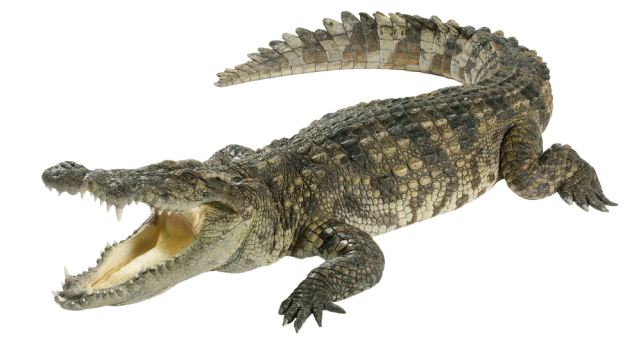Stamp: Nile Crocodile (Crocodylus niloticus) (Umm al-Qiwain 1972)
Nile Crocodile (Crocodylus niloticus) (Umm al-Qiwain 1972)
01 January (Umm al-Qiwain ) within release Animals (I), large format goes into circulation Stamp Nile Crocodile (Crocodylus niloticus) face value 1 Qatari riyal
| Stamp Nile Crocodile (Crocodylus niloticus) in catalogues | |
|---|---|
| Michel: | Mi: UM 1012B |
| Colnect codes: | Col: UM 1972.00.00-222k |
Stamp is horizontal format.
Also in the issue Animals (I), large format:
- Souvenir Sheet - African Elephant (Loxodonta africana) face value 1;
- Stamp - African Elephant (Loxodonta africana) face value 1;
- Stamp - Alpine Chamois (Rupicapra rupicapra) face value 1;
- Souvenir Sheet - Alpine Chamois (Rupicapra rupicapra) face value 1;
- Souvenir Sheet - Black Rhinoceros (Diceros bicornis) face value 1;
- Stamp - Black Rhinoceros (Diceros bicornis) face value 1;
- Stamp - Cheetah (Acinonyx jubatus) face value 1;
- Stamp - Cheetah (Acinonyx jubatus) face value 1;
- Souvenir Sheet - Cheetah (Acinonyx jubatus) face value 1;
- Souvenir Sheet - Cheetah (Acinonyx jubatus) face value 1;
- Stamp - Chimpanzee (Pan troglodytes) face value 1;
- Souvenir Sheet - Chimpanzee (Pan troglodytes) face value 1;
- Souvenir Sheet - Giraffe (Giraffa camelopardalis) face value 1;
- Stamp - Giraffe (Giraffa camelopardalis) face value 1;
- Stamp - Giraffe (Giraffa camelopardalis) face value 1;
- Souvenir Sheet - Giraffe (Giraffa camelopardalis) face value 1;
- Souvenir Sheet - Guanaco (Lama guanicoë) face value 1;
- Stamp - Guanaco (Lama guanicoë) face value 1;
- Souvenir Sheet - Hamadryas Baboon (Papio hamadryas) face value 1;
- Stamp - Hamadryas Baboon (Papio hamadryas) face value 1;
- Souvenir Sheet - Horse (Equus ferus caballus) face value 1;
- Stamp - Horse (Equus ferus caballus) face value 1;
- Souvenir Sheet - Lion (Panthera leo) face value 1;
- Stamp - Lion (Panthera leo) face value 1;
- Souvenir Sheet - Nile Crocodile (Crocodylus niloticus) face value 1;
- Stamp - Nile Crocodile (Crocodylus niloticus) face value 1;
- Stamp - Titi (Callicebinae) face value 1;
- Souvenir Sheet - Titi (Callicebinae) face value 1;
- Souvenir Sheet - White Rhinoceros (Ceratotherium simum) face value 1;
- Stamp - White Rhinoceros (Ceratotherium simum) face value 1;
- Stamp - Zebra (Equus sp.) face value 1;
- Souvenir Sheet - Zebra (Equus sp.) face value 1;
Stamp Nile Crocodile (Crocodylus niloticus) it reflects the thematic directions:
Amphibians are ectothermic, anamniotic, four-limbed vertebrate animals that constitute the class Amphibia. In its broadest sense, it is a paraphyletic group encompassing all tetrapods, excluding the amniotes (tetrapods with an amniotic membrane, such as modern reptiles, birds, and mammals). All extant (living) amphibians belong to the monophyletic subclass Lissamphibia, with three living orders: Anura (frogs), Urodela (salamanders), and Gymnophiona (caecilians). Evolved to be mostly semiaquatic, amphibians have adapted to inhabit a wide variety of habitats, with most species living in freshwater, wetland or terrestrial ecosystems (such as riparian woodland, fossorial and even arboreal habitats). Their life cycle typically starts out as aquatic larvae with gills known as tadpoles, but some species have developed behavioural adaptations to bypass this.
Animals are multicellular, eukaryotic organisms of the kingdom Animalia (also called Metazoa). All animals are motile, meaning they can move spontaneously and independently, at some point in their lives. Their body plan eventually becomes fixed as they develop, although some undergo a process of metamorphosis later on in their lives. All animals are heterotrophs: they must ingest other organisms or their products for sustenance.
Crocodiles (family Crocodylidae) or true crocodiles are large semiaquatic reptiles that live throughout the tropics in Africa, Asia, the Americas and Australia. The term crocodile is sometimes used even more loosely to include all extant members of the order Crocodilia, which includes the alligators and caimans (family Alligatoridae), the gharial and false gharial (family Gavialidae) among other extinct taxa.
Reptiles are tetrapod (four-limbed vertebrate) animals in the class Reptilia, comprising today's turtles, crocodilians, snakes, amphisbaenians, lizards, tuatara, and their extinct relatives. The study of these traditional reptile orders, historically combined with that of modern amphibians, is called herpetology. Because some reptiles are more closely related to birds than they are to other reptiles (e.g., crocodiles are more closely related to birds than they are to lizards), the traditional groups of "reptiles" listed above do not together constitute a monophyletic grouping (or clade). For this reason, many modern scientists prefer to consider the birds part of Reptilia as well, thereby making Reptilia a monophyletic class.




